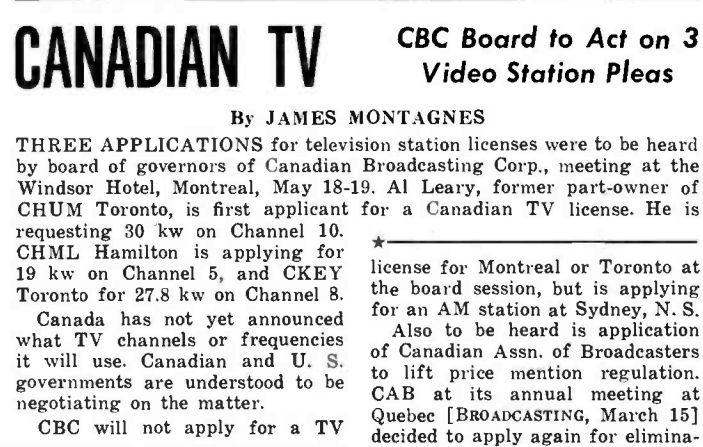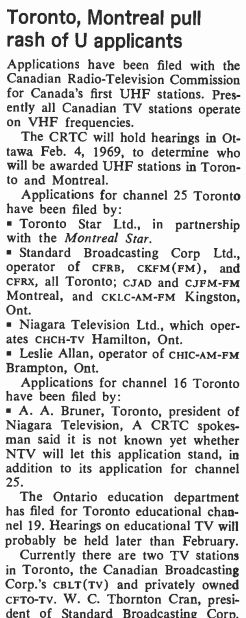- RadioActive
- Moderator
 Offline
Offline
Why Toronto's TV Dial Could Have Looked Very, Very Different
We all know the TV stations in Toronto. Channel 5, channel 10 and channel 8. Wait, what?
That's what you could have grown up with if things have worked out differently. In 1948, when the new medium was just getting started, several players desperately wanted to get signals on the air to own a chunk of the spectrum space. One of them was CHUM in the pre-Allan Waters days, another was CKEY, and a third was CHML in Hamilton. This was four years before the CBC debuted on what at the time was channel 9 (later moving to 6 and then 5.)
It was a time before the U.S. and Canada had even decided on channel allocations, but imagine what our broadcast landscape might have looked like if those owners had managed to secure those early licences.
From May 1948:
Flash forward 20 years. It's now 1968, the CRTC was starting to explore UHF and there were a plethora of parties trying to get a coveted TV space - on channel 25. A lot of different people wanted that precious frequency, including the Toronto Star, Standard Broadcasting and - God help us - one of the Allan brothers from CHIC-AM in Brampton.
As we know now, it went to CBC's French service. But you have to wonder what kind of station Leslie Allan would have run. 
- RadioAaron
- Member
 Offline
Offline
Re: Why Toronto's TV Dial Could Have Looked Very, Very Different
Fun little error in that second article; Standard never owned CKLC.
- mace
- Member
 Offline
Offline
Re: Why Toronto's TV Dial Could Have Looked Very, Very Different
Interesting that this conference was held May 18 and 19 in 1948. Canada was just starting to think about television, not actually do anything. Meanwhile, WBEN CH 4 in Buffalo had already been operating for four days! It would take another four years of dithering by the Canadian government before television came to Canada. Meanwhile, those who could afford a set had four years to get hooked on American television. With the exception of local news, HNIC, Front Page Challenge and the occasional Wayne & Shuster special, Canadian eyes remained glued to channels in the U.S. for decades.
- RadioActive
- Moderator
 Offline
Offline
Re: Why Toronto's TV Dial Could Have Looked Very, Very Different
Also worthy of note, if they had assigned channels 5 and 10 to Toronto, that also would have almost certainly changed the history of TV in Rochester.
WROC started life on channel 5 (with the call letters WHAM, now on channel 13), before moving to channel 8, while WHEC has long been the occupant of channel 10.
You wonder where those stations might have ended up on the dial if those frequencies had been in use here.
- •
- paterson1
- Member
 Offline
Offline
Re: Why Toronto's TV Dial Could Have Looked Very, Very Different
We have to remember as well, the numbers of televisions in Canada were small. In 1951, across the whole country there were only around 90,000 televisions. In 1953 a few months after CBC launched the total was over 300,000, again not a huge number. A few years later it would be over 1 million. Interesting article with the Roots of Canadian Television written by Ian Anthony from Broadcaster Magazine.
- MJ Vancouver
- Member
 Offline
Offline
Re: Why Toronto's TV Dial Could Have Looked Very, Very Different
RadioActive wrote:
Also worthy of note, if they had assigned channels 5 and 10 to Toronto, that also would have almost certainly changed the history of TV in Rochester.
WROC started life on channel 5 (with the call letters WHAM, now on channel 13), before moving to channel 8, while WHEC has long been the occupant of channel 10.
You wonder where those stations might have ended up on the dial if those frequencies had been in use here.
London wouldn’t have had Channel 10 in that case either - too close to Toronto.
Last edited by MJ Vancouver (May 10, 2023 12:08 am)
 1 of 1
1 of 1